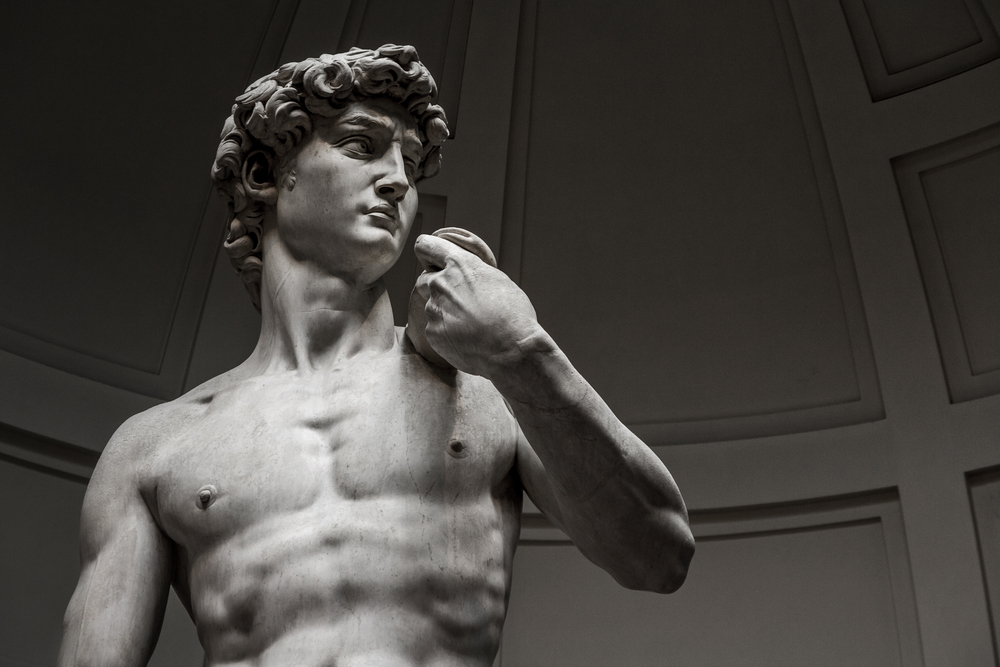Michelangelo was a liar.
Think of someone super successful.
A musician. An actor. An athlete.
What does their life look like? They’ve got it made, right? Walking red carpets, selling out stadiums, and living the dream.
Now think of an artist.
Did you picture the same thing? Or are they living in a studio apartment, struggling to get by, and sacrificing their financial well being for the sake of their art?
We’re taught that to be an artist you’ve got to hurt to be great. To starve, even. That phrase, “starving artist”, is basically a cliché at this point.
Think of Michelangelo. Not the pizza loving nunchucks-wielding turtle, but the Renaissance master. He was a starving artist, right?
Born in Italy in 1475 during the birth of the Renaissance, he mastered sculpture, architecture, and painting. A medium he believed to be inferior by the way. (The man who painted the Sistine Chapel didn’t like to paint! WTF.)
I went to Italy in 2013 and stood before his statue David. I gazed up at the ceiling of the Sistine Chapel for almost an hour. They filled me with awe and wonder. The detail. The scale. They were mind boggling. No wonder he is considered one of the greatest artists of all time.
Michelangelo lived a spartan lifestyle, often booking just a single bed for him and his assistants. His family members wrote to him, asking him for money, and he responded that he had none to give. He'd say his life as an artist left him “poor, old, and working as a servant of others”.
How could a man who sculpted the Pietà and David before he was 30 be so poor?He worked for the wealthiest patrons of the Renaissance, but died at 88 with relatively little wealth compared to his fame. Right?
But here’s the thing. Michelangelo was a liar. He was, in fact, one of the wealthiest artists to have ever lived.
Recently, an art historian discovered previously unknown bank accounts belonging to Michelangelo, suggesting he was wealthier than Scrooge McDuck, but just as frugal.
One client paid him more than $600,000 a year and another paid over $10,000,000 for a project he didn’t even finish! (Adjusted for inflation of course.)
So why is there all this continued nonsense about the starving artist, one even Michelangelo seemed to sustain?
This stereotype persists for two reasons:
We assume it’s part of the process of being a creative.
Plain and simple, most creatives perfect their craft, while failing to master the art of doing business.
We’re brainwashed to believe that as a creative you have to suffer to be an artist.
If we build up the myth of the artist, we simultaneously build up the myth of their work. Would Van Gogh be as memorable with both ears and a happy spirit? Would Picasso be so celebrated if he believed himself understood?
This is not necessary or true. Michelangelo was not only one of the best artists of all time but was also a clever businessman.
So often I see video creators with no (or little) business experience struggle to put the systems in place to be financially successful. But that doesn’t have to be the case.
You can be a creative AND a successful business owner. You just have to master that side of your craft as well.
Four years ago, I decided to leave my dream job at Fizzle and start my own video business. Leaving a stable paycheck was terrifying. My wife was starting wedding photography business of her own, we had rent to cover, student loans to pay off, and medical bills piled high from my wife’s cancer treatments.
I was scared but I knew I had to take a chance on myself.
Fast forward, I’m earning more money than ever before and have a full-time employee. I work when I want for who I want and take a month off each year to travel internationally.
I’ve launched, sustained, and grown a successful six figure business as a creative and I can help you do the same.
Next week, on November 12, I am launching an intensive, 3-month long accelerator program for freelance filmmakers.
The program will include weekly group calls and discussions, a private community, templates, lists, docs, and process checklists that I use every day.
We will dive deeeeep into how I run my own business and how the systems I have in place will help you to grow your income and streamline your processes, saving you time and money.
I’ll help take you from a starving artist mentality and put you on track to be the Renaissance master you could be (or mutant ninja turtle, whichever you prefer).
To read more about the wealth of Michelangelo, read this New York Times article or the original research by Hatfield. Shout out to my wife Jen with her art history degree (obsession, really) and sharing this story with me.

